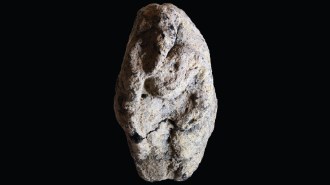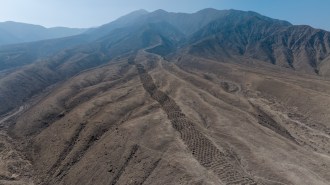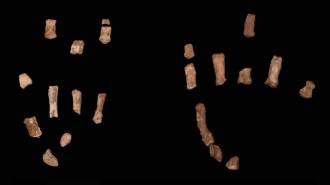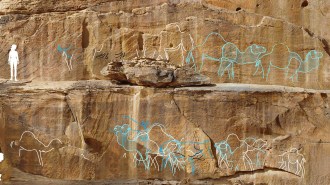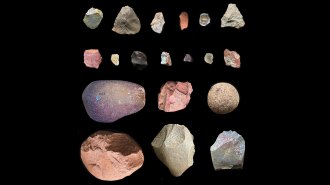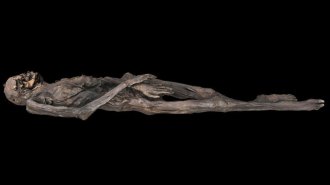Ancient Asian Tools Crossed the Line
Large stone-cutting tools dubbed hand axes regularly appear at prehistoric archaeological sites from India westward across southern Asia into Europe and Africa. In 1944, Harvard anthropologist Hallam L. Movius Jr. proposed that those prehistoric populations, living 1.6 million to 200,000 years ago, existed on one side of a geographical line that separated them from groups in central and eastern Asia, where early humans fashioned much simpler stone implements.
Now, the discovery of ancient hand axes in southern China’s Bose basin supports the growing suspicion that hand ax production sometimes crossed what archaeologists call the Movius line. The 800,000-year-old Asian tools look much like Stone Age hand axes from anywhere else, concludes a team led by Hou Yamei of the Chinese Academy of Sciences in Beijing and Richard Potts of the Smithsonian Institution’s National Museum of Natural History in Washington, D.C.
Other new evidence gathered by the scientists suggests that an ancient meteorite destroyed forests in southern China and temporarily exposed rocky outcrops in the Bose basin. Human ancestors, either longtime residents or recent arrivals to the region, then had access to large clumps of rock that they could hammer and chip into hand-held axes, the researchers hold.
“Our work suggests that evidence for cultural differences doesn’t occur in early human behavior,” Potts asserts. “Given a particular kind of open environment, human ancestors everywhere produced the same kinds of stone tools for hundreds of thousands of years.”
Yamei, Potts, and their colleagues analyzed 991 stone artifacts found at 24 sites in the Bose basin. This collection includes 35 pear-shaped hand axes featuring two sharpened edges running up opposite sides above a rounded base.
The researchers describe their discoveries in the March 3 Science. They also report that sediment at the three excavation sites that yielded the tools contains rocks that had undergone intense heating. Laboratory analysis of argon isotopes in the rocks from Bose dated the heating to about 803,000 years ago.
The scientists suspect that the heated rocks resulted from a meteorite’s impact or its explosion in Earth’s atmosphere in the vicinity of Indonesia at around the same time. Independent examinations of ocean cores have documented such an occurrence.
Increasing evidence from the Bose basin and sediment beneath the South China Sea suggests that the region fluctuated from drier to wetter conditions for much of the Stone Age, Potts asserts. In his view, this suggests that periodic access to rock sources in drier times, when there was less vegetation, encouraged hand ax production among the region’s longtime residents.
The discovery of the Bose hand axes “implies similar technical, cultural, and cognitive capabilities on both sides of the Movius line,” Potts says.
The Bose axes resemble those from elsewhere without slavishly duplicating them, comments anthropologist F. Clark Howell of the University of California, Berkeley. Like Potts, Howell suspects that Homo erectus groups living in Asia developed their own traditions of hand ax production when suitable rock became available.
Stanley H. Ambrose, an archaeologist at the University of Illinois at Urbana-Champaign, disagrees. The double-edged Bose tools are indistinguishable from those in Africa and southern Asia, he contends.
“You could lose the Bose stuff in the [stone artifacts] from Africa that we have in our university collection,” Ambrose maintains.
Widespread forest destruction caused by the ancient meteorite event probably spurred H. erectus groups in India to migrate into eastern Asia, where they made the Bose hand axes, he proposes.
Some more western population must have brought an established hand ax tradition to eastern Asia, concurs archaeologist Ofer Bar-Yosef of Harvard University. For the bulk of the Stone Age, ancestral peoples rigidly adhered to toolmaking styles dictated by cultural conventions, not the type or amount of rock available, Bar-Yosef argues.
For instance, some European Stone Age sites contain good rock for hand axes but yield only simpler stone flakes, he notes.
“The Bose finds are an exception,” Bar-Yosef says. “They don’t destroy the Movius line.”

